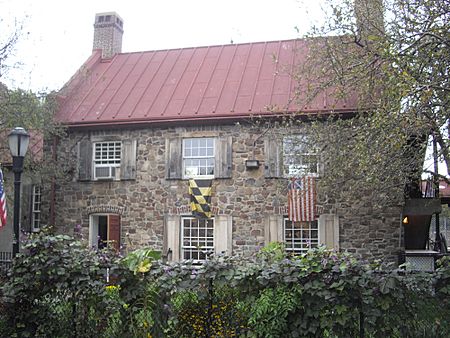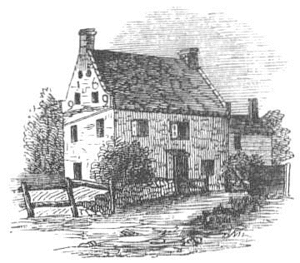Old Stone House (Brooklyn) facts for kids
 |
|
| Established | 1934 |
|---|---|
| Location | 336 3rd Street (between 4th and 5th Ave) Brooklyn, New York City |
The Old Stone House is a special building in Brooklyn, New York City. It is located in the Park Slope area. You can find it inside the J. J. Byrne Playground, which is part of Washington Park. The house sits on Third Street, between Fourth and Fifth Avenues. Long ago, a creek called Gowanus Creek flowed nearby. Today, the Gowanus Canal is about 1,300 feet (400 m) west of the house.
The building you see today was rebuilt in 1933. It uses some of the original stones from the first house. The first house was called the Vechte–Cortelyou House. It was very important during the 1776 Battle of Long Island in the American Revolutionary War.
At one time, the Old Stone House was even a clubhouse for a baseball team! This team was the Brooklyn Superbas, who later became the famous Brooklyn Dodgers. The house was added to the National Register of Historic Places in 2012.
The First House: A Historic Home
The Old Stone House you see today is a copy of an old Dutch stone farmhouse. It was built around 1699 by a Dutch immigrant named Claes Arentson Vechte, or his son Hendrick. It is also known as the Vechte–Cortelyou House.
The Vechte family were farmers. They grew crops on the land around the house. They also collected oysters from Gowanus Creek. They would take their goods down the creek to Gowanus Bay. From there, they would go to lower Manhattan to sell them.
Over the years, the house was rented and passed down through families. In 1766, Isaac Cortelyou rented it. Later, it went back to the Vechte family. In 1779, Nicholas Cowenhoven inherited it. He sold it to Jacques Cortelyou in 1790. Jacques gave it to his son, Peter, as a wedding gift.
The Battle of Long Island: A Key Location
On August 27, 1776, the house played a big part in the Battle of Long Island. This was a major battle during the American Revolutionary War. It was the first big fight for the Continental Army after the Declaration of Independence. It was also the largest battle of the entire war.
That day, at 9:00 am, George Washington arrived from Manhattan. He learned that the British were close to breaking through American lines. Washington realized the British had tricked him. He quickly ordered more troops to Brooklyn from Manhattan.
On the American right side, General Stirling held his position against the British General Grant. Stirling fought for four hours. He did not know that the British were moving around his left side. Some of his soldiers even thought they were winning. This was part of the British plan.
At 11:00 am, British General Grant attacked Stirling's center. He had 2,000 more soldiers. Stirling was also attacked on his left by German soldiers called Hessians. Stirling had to pull back. But British troops were now coming from behind him. The only way to escape was across a pond on Gowanus Creek. This pond was 80 yards wide. On the other side was Brooklyn Heights, where American forces were.
The Brave "Maryland 400"
General Stirling told most of his troops to cross the creek. But he ordered a group of Maryland soldiers to stay behind. These soldiers were led by Major Mordecai Gist. This group became known as the Maryland 400. There were actually about 260–270 men.
Stirling and Gist led these brave Marylanders. They fought against more than 2,000 British soldiers and two cannons. The Marylanders attacked the British twice. The British were set up in and around the Vechte–Cortelyou House (the Old Stone House).
After their last attack, the remaining Marylanders tried to cross Gowanus Creek. Some got stuck in the mud under enemy fire. Others could not swim and were captured. Stirling himself was surrounded. He did not want to surrender to the British. So, he broke through their lines and surrendered to the Hessians instead.
A total of 256 Maryland soldiers were killed in front of the Old Stone House. Fewer than a dozen made it back to the American lines. General Washington watched from a nearby fort. He was reported to have said, "Good God, what brave fellows I must this day lose!"
The 256 dead Maryland soldiers were buried in a large grave. It was on a small hill on farmer Adrian Van Brunt's land. This battle is why Maryland is called "The Old Line State." This mass grave is thought to be near 3rd Avenue, between 7th and 8th Streets today.
After the house was captured, the British used it as a place to fire cannons. About 2,000 British and Hessian soldiers shot at the Americans. The Americans had already lost many soldiers. They were running from the east to their forts across Gowanus Creek. The Maryland Brigade tried to take the house back twice. But they were pushed back by the British, losing many more soldiers.
Nicholas Vechte, a grandson of Claes, lived in the Old Stone House during the British occupation. When he died in 1779, he left the farm to his grandson, Nicholas R. Cowenhoven. In 1797, Cowenhoven sold the house to Jacques Cortelyou. Jacques bought it for his son, Peter, who had just gotten married. Peter's son Jacques inherited the house in 1815. His family was the last to live in the Old Stone House.
After his wife died, Jacques Cortelyou sold the property in 1852. The buyer was Edwin Litchfield, who built railroads. Litchfield lived in Litchfield Villa, which is now the Brooklyn office for the New York City Department of Parks and Recreation. Litchfield owned most of the farmland in the area. He sold much of his land to the city to create Prospect Park.
A Baseball Clubhouse
After Litchfield bought it, the Old Stone House stood for another forty years. A caretaker lived there during that time. It was also used as a clubhouse for a winter skating team. Later, it became a clubhouse for a professional baseball team. This team was called the Brooklyn Superbas. They later became the famous Brooklyn Dodgers before moving to Ebbets Field.
The Old Stone House is on the site of the first Washington Park. This was one of the oldest professional baseball stadiums in New York. The second Washington Park was across Fourth Avenue. Part of the left-center field wall from the second Washington Park can still be seen today. It is on Third Avenue between First and Third Streets.
The Old Stone House Today: A Museum
The land where the house stood was bought by the New York City Department of Parks and Recreation in 1923. The original house had been torn down and burned in 1897. In 1933, workers dug up the site. Half of the house was below street level because Fourth Avenue had been raised.
The house was rebuilt in 1934. Many of the original stones were used. It was moved a little from its first spot. At first, it was used as a rest room. Later, it was fixed up more in the 1970s and 1990s. It became a memorial to the Battle of Long Island. This happened because of a group called the First Battle Revival Alliance. To honor the brave Maryland soldiers, the flag of Maryland flies at the house.
Today, the Old Stone House is a Historic Interpretive Center. It is run by a non-profit group called the Old Stone House of Brooklyn (OSH). They work with the Parks Department. Inside, you can see an exhibit about the battle. OSH also offers school visits to teach about the house's history and the battle. They have many concerts, readings, talks, and other events. It is also used for a summer camp, Piper Theatre, and special events like sing-alongs to the musical Hamilton.
See also
- Battle Hill
- Battle Pass
- Revolutionary War Heritage Trail




